
MUSIC
Mahler’s Song Of The Earth ★★★★
Australian Chamber Orchestra, Melbourne Recital Centre, May 13
A rare chance to hear two distinguished Australian operatic voices with the Australian Chamber Orchestra in an intriguing program resulted in a packed house for the first of three Melbourne performances of Gustav Mahler’s Das Lied von die Erde (The Song of the Earth). It was ingeniously but empathetically arranged by fellow composer and admirer Arnold Schoenberg in 1920, and later completed by German composer Rainer Riehn.
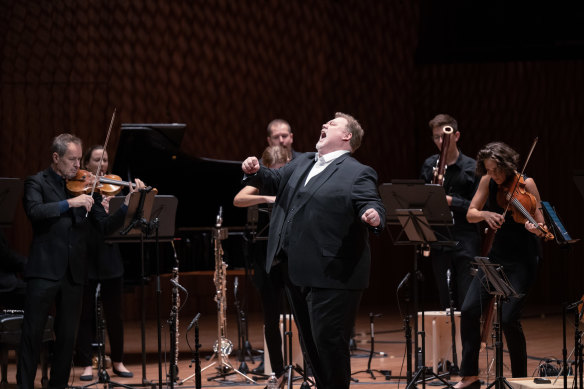
An exotically flavoured meditation on life, love and death: the Australian Chamber Orchestra with tenor Stuart Skelton.Credit: Nic Walker
Preceding this profound, exotically flavoured meditation on life, love and death came other amorous declarations. Wagner’s Siegfried Idyll, a birthday present for his wife, Cosima, was given an ardently romantic account in its original version for 13 players.
Three songs by Mahler’s wife, Alma Mahler-Werfel, revealed a gifted and evocative compositional talent. While singing with dedication and textual insight, these songs challenged mezzo-soprano Catherine Carby as they predominantly sat low in her range, where the orchestration (by British composer David Matthews) did not always aid the projection of the colour and clarity that were an attractive feature of the higher reaches of her instrument.
Happily, the range and orchestration of the Mahler suited Carby very well indeed. This was not so true of Carby’s collaborator, tenor Stuart Skelton, who did his valiant best to cover signs of apparent vocal strain throughout his three quite demanding songs. In this, he could have been better served by ACO director Richard Tognetti, who had the ability to rein in his exuberant players, most notably in the opening song.
Carby’s contributions, however, were of stellar quality. Deeply inhabiting text and mood, especially in the long, final farewell, she radiated all the intense emotions of the human condition with disarming, heart-rending candour. Complemented by a fine ensemble that included flautist Sally Walker, pianist Stefan Cassomenos, cellist Timo-Veikko Valve and hornist Timothy Jones, this was a moving, if imperfect, night to remember.
Reviewed by Tony Way
MUSIC/THEATRE/DANCE
The Bridal Lament 哭嫁歌 ★★★★
Arts House, until May 19
In the culture of Weitou, the earliest settlers of Hong Kong from southern China, marriage was akin to a kind of spiritual death for women. As a final act of defiance before they were sent off to live with their arranged husbands, the women developed a ritual known as the bridal lament. The woman would go up to a loft for three days, and there, suspended above her world, she would sing songs to her family and friends describing what she was leaving behind.
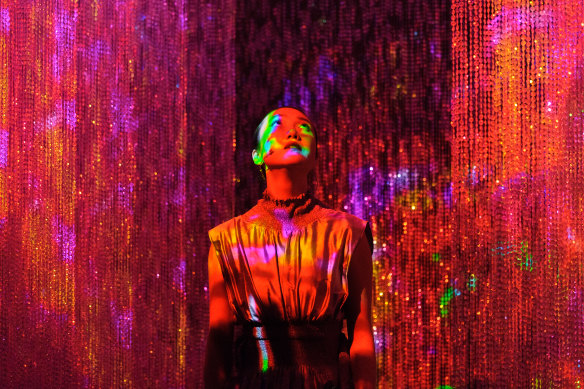
The Bridal Lament, starring Rainbow Chan, at Arts House.Credit: Sarah Walker
Multidisciplinary artist and musician Rainbow Chan, whose mother is Weitou, reimagines this world in an ambitious one-woman show, directed by Tessa Leong. After making its debut at Sydney’s Liveworks last year and heading to Adelaide’s OzAsia festival, and now playing in Melbourne, The Bridal Lament is a tender, poignant and cinematic vision of Chan’s place between cultures.
The Bridal Lament is many things at once. It has elements of music, both contemporary and ancient, as Chan’s thudding electro-pop melds with traditional Weitou laments in a song cycle form; visual art, with abstract, swirling video projections designed by Rel Pham; and spoken-word, with Chan (and her mother, Irene, via voiceover in Weitou and Cantonese) narrating the story of the rituals, and the story of their family’s migration to Australia. The backdrop is an elaborate, beaded archway, animated by dazzling colours.
Chan’s gorgeous voice is the backbone of the show: soft when singing the folksy laments, and furiously commanding on the more modern pop-driven music, where it is sometimes distorted with autotune. The single Seven Sisters is a particular highlight as the archway pulses with colour. Other pieces flirt with ambient styles, adding to the haunting atmosphere. Choreography also plays a part: Chan’s body contorts as she glides across the stage, or writhes on the floor. The language of the laments is translated via video, and it is stunningly poetic, with vivid imagery of fruit and animals illustrating the bride’s plight.
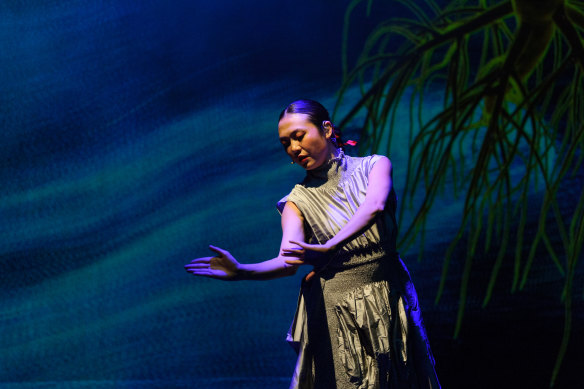
As well as her gorgeous voice, Rainbow Chan’s gliding movement is a big part of The Bridal Lament.Credit: Sarah Walker
The meta-narration is the show’s weakest point, as Chan breaks the fourth wall to speak directly to the audience about what she experienced and learnt. While informative, it disrupts the flow of the piece, and jolts the viewer out of the liminal world of the laments.
Loading
The Bridal Lament is a rich and layered third-culture meditation on ritual, heritage and loss. When it ends, Chan is in tears. It’s a privilege to go on this emotional journey with her.
Reviewed by Giselle Au-Nhien Nguyen
MUSIC
Adrian Sherriff’s Kalachakra Ensemble ★★★★★
Mark Street Hall, May 10
Kalachakra is a Sanskrit word meaning “cycles of time” – a multidimensional concept that lies at the heart of Adrian Sherriff’s marvellous new ensemble. The group’s music is based on Carnatic (south Indian) traditions, including its complex rhythmic cycles.
And the group’s formation was inspired by a decades-long connection between two of its members – Sherriff and Sandy Evans – and the late Indian percussionist, Karaikudi R. Mani.
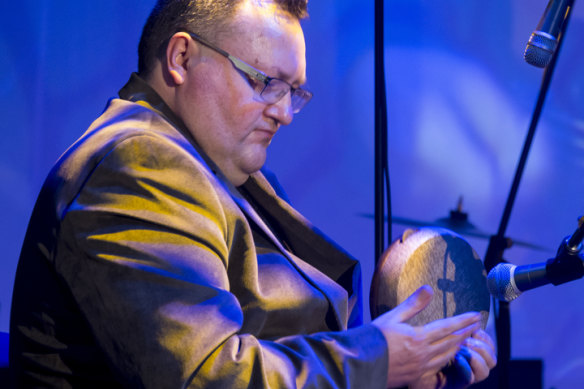
Adrian Sherriff leads the Kalachakra Ensemble.Credit: Ian Spence
The debut performance by Kalachakra on Friday night (presented by The Boite) also marked a significant anniversary: one year since Mani’s passing. Sherriff opened the concert by acknowledging Mani’s profound influence on his own musical growth, having studied and performed with the Indian master since the late 1990s.
But while Sherriff has a deep understanding of Carnatic music, he’s also a jazz artist, and this concert was an enthralling amalgam of cultures and traditions.
Sherriff, an immensely gifted multi-instrumentalist, performed on the double-headed mridangam, the instrument Mani played throughout his life. Together with the remarkable Jay Dabgar on tabla, Sherriff created elaborate rhythmic patterns that underpinned each composition.
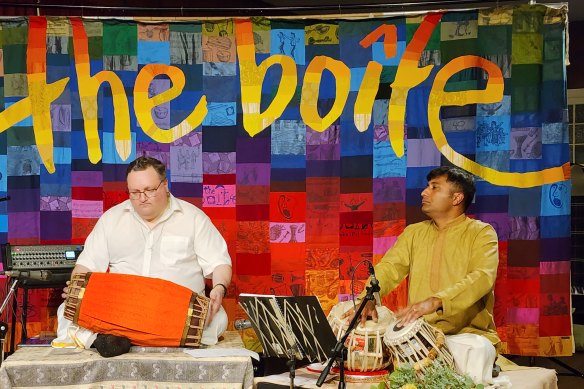
Enthralling amalgam: Adrian Sherriff was joined by the remarkable Jay Dabgar on tabla.Credit: Jessica Nicholas
Melodies based on south Indian ragas were brought to life by Evans’ saxophone, Peggy Lee’s cello and Rohan Dasika’s double bass. It was fascinating to watch these three instrumentalists articulating intricate rhythmic and melodic motifs with breathtaking unison, while also weaving in contrapuntal lines or breaking off into spirited improvisations.
Dasika and Lee switched nimbly between arco and pizzicato, adding subtle harmonics, richly resonant undertones or an undulating pulse to echo the two percussionists. Evans was frequently locked in sync with the bass and cello, but also produced some mesmerising solos, darting from note to note with astonishing agility or sinking into slow, sustained phrases with prayerful reverence.
This was a compelling tribute not just to Mani’s legacy, but to the creative processes that can carry ancient traditions into the future.
Reviewed by Jessica Nicholas
MUSIC
Jaime Conducts Debussy and Strauss ★★★★
Melbourne Symphony Orchestra, Hamer Hall, May 9
Jaime Martin and the MSO offered a night of high drama – exactly as planned – with two virtuoso works by Claude Debussy and Richard Strauss, plus a rarely played overture.
The ambitious program of Debussy’s La Mer (The Sea) and Strauss’ Ein Heldenleben (A Hero’s Life) require on the podium both a fine colourist and a master musical architect, and chief conductor Martin is both. He balanced the shape, line and proportion of each work, energetically combining both the sweep and the detail.
The MSO was augmented by one or two Australian National Academy of Music students in each section, and it must have been thrilling for them to take part in such an explosive concert before a fully appreciative audience.
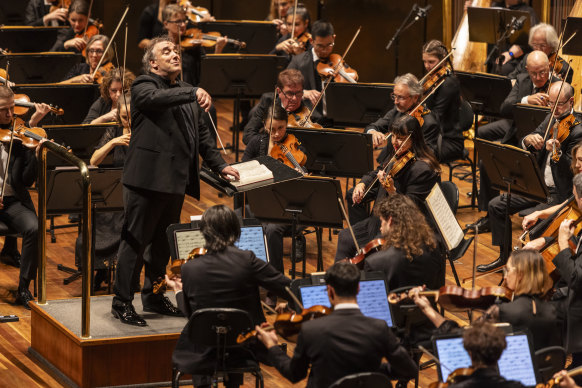
Jaime Martin and the Melbourne Symphony Orchestra provided a night of high drama.Credit: Mark Gambino
First came the overture to The Wreckers, an opera about Cornish villagers who lure ships to their doom. By Dame Ethel Smyth, a suffragette whose protests meant she was jailed, it was lively and attractive.
A contemporary critic said La Mer should be titled La Mal de Mer (seasickness), while composer Erik Satie said of the movement Dawn to Noon on the Sea that he liked the bit about a quarter to 11. So did I, but I also enjoyed the rest – a subtle and characterful reading.
The highlight was the Strauss, rather immodestly based on the composer’s own life. “I find myself quite as interesting as Napoleon” (the original dedicatee of Beethoven’s Eroica symphony), he said.
Martin opened lickety-split, at the cost of some blurred detail, but built irresistible momentum. This tempo in the second section, “the hero’s enemies” (unsympathetic critics), with carping woodwinds and grumbling bass, made the critics all the more shrill.
Next, “the hero’s companion”, captured Strauss’ wife, Pauline, in a tender and flirtatious account distinguished by sumptuous playing by associate concertmaster Tair Khisambeev in the challenging extended solo. In summary, a formidable feat of physical fitness and concentration by all involved.
Reviewed by Barney Zwartz
THEATRE
World Problems ★★★
Emma Mary Hall, Melbourne Theatre Company, until May 22
How does knowledge of the global – including catastrophes from nuclear war to climate change – affect our experience at a personal level? How might the smallest corners of our lives be connected, through some butterfly effect, to outcomes much bigger than ourselves?
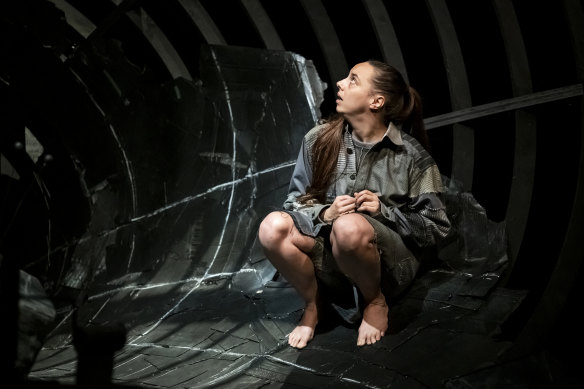
Carly Sheppard’s performance in World Problems is filled with wry wit.Credit: Tiffany Garvie
World Problems invites the audience to consider such questions, in an hour-long monologue featuring historical disasters and speculative futures, all nestled within the ephemera of childhood memory.
A lone woman (Carly Sheppard) scrambles through what looks like a wrecked fuselage to take the stage. Concrete fragments of recollection build a vivid, culturally precise portrait of growing up as a Gen X queer girl in the Adelaide suburbs, but the dramatic structure is quite poetic and abstract and free-associative, with a universalising impulse.
It reminded me, oddly enough, of the text in Nature Theatre of Oklahoma’s Life and Times – a masterpiece of avant-garde verbatim theatre that used recordings of a woman recalling her childhood in pedestrian detail, complete with “ums” and “ahs” – and it shares the same creative leaps, lacunae and unbidden thoughts of a person compelled to relate memories in real time.
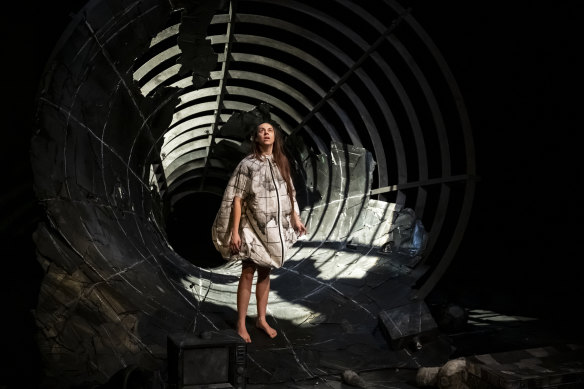
World Problems is an hour-long monologue featuring historical disasters and speculative futures.Credit: Tiffany Garvie
Sheppard wrestles the chaos of experience into narrative (or the suggestion of it) with wry wit and a coiled presence that embodies the struggle posed by self-reflection. Observations on gender and sexuality are especially sharp, but Sheppard also shows how the character’s personal and social identity are shaped by cultural trends and world events, including all the touchstones of the last generation to grow up without the internet.
Loading
As the woman remembers her young adulthood, middle age and begins to approach her present, a twist replaces memory with futuristic intimations: apocalyptic dystopias where birds fall out of the sky, or transhuman ones where technology transforms social norms, and people start marrying their own fridges or what have you.
These speculative incursions feel underdeveloped on their own terms.
They will seem more so to theatregoers who saw Sheppard’s previous one-woman show, Chase, about the last First Nations woman left alive on a ruined planet, where a similar, more elaborate dystopian technique was deployed with great success.
Still, the anticlimax doesn’t undermine the integrity of the production, nor does it overshadow the skill or charisma of the central performance, which creates an intimate interior landscape, bristling with all the questions that reflecting on your own story, and how it connects with the bigger picture, can provoke.
Reviewed by Cameron Woodhead
The Booklist is a weekly newsletter for book lovers from books editor Jason Steger. Get it every Friday.



























